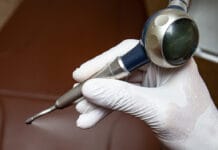Due to the extensive knowledge of head and neck anatomy and the amount of time we spend assessing and evaluating our patients, dental hygienists may be in a unique position to identify jaw claudication, which may indicate giant cell arteritis. Additionally, the treatment for giant cell arteritis may have oral health implications that dental hygienists should be aware of.
Jaw claudication is a term that refers to pain, tenderness, and tiredness along the jawline and facial muscles when speaking or chewing. The pain and tiredness are caused by inflammation of the internal maxillary, facial, and temporal arteries, which decreases the blood and oxygen supply to the masseter and other jaw muscles. The soreness usually resolves once these activities stop and the muscles are allowed to relax.1,2
Jaw claudication is a hallmark sign and most specific symptom of a disease known as giant cell arteritis (GCA). GCA is a form of systemic vasculitis that refers to the inflammation of blood vessels.3 This vasculitis affects the arteries of the aorta, subclavian, iliac, ophthalmic, vertebral, occipital, temporal, and accessory arteries of the head and scalp.4,5
Giant Cell Arteritis Origin, Etiology, and Risk Factors
GCA was discovered in 1890 and has been known by many other names, including Horton arteritis, arteritis of the aged, granulomatous arteritis, cranial arteritis, and temporal arteritis.5
GCA is a result of immune-mediated inflammation, which causes changes to a vessel wall. The exact etiology is unknown, but it is thought to be caused by the body’s inappropriate inflammatory response to vascular injury.5 “The inflammatory process leads to vessel scarring, narrowing, severe stenosis, and eventually occlusion.”1
Risk factors include being over 50 years old, with an average age of onset being 75, familial history of GCA, and history of polymyalgia rheumatica.1,2,4,5 The highest incidence of GCA is among those with Scandinavian heritage.5 Women are two to three times more susceptible to GCA than men.1
Signs and Symptoms of Giant Cell Arteritis
Most commonly, symptoms of GCA progress over weeks to months. However, in some cases, the onset is sudden and abrupt.4 Jaw claudication affects over 30% of patients with GCA, making its presence an indicator of GCA.5
In addition to jaw claudication, other symptoms of GCA may exist because of the location of the affected arteries.2 The most common symptom of GCA is headaches, most often around the temples, in which the pain can be severe.3,5 Temporal headaches occur in 60% to 90% of those diagnosed with GCA.5
Patients may experience vision impairment, such as double vision or vision loss in one or both eyes. Initially, vision disturbances may only last for a few minutes and then resolve on their own. However, if treatment is delayed, permanent vision loss may occur within hours or days.4
Flu-like symptoms can also be common with GCA. These can include low-grade fever, loss of appetite, weight loss, and fatigue.1-5
It is estimated that 50% of patients suffering from GCA have tenderness, swelling, and pulse loss at the temporal artery.5
Diagnosis of Giant Cell Arteritis
GCA can be difficult to diagnose early on because the signs and symptoms, such as headache and flu-like symptoms, resemble those of other common conditions.5
The conventional gold standard for a definitive diagnosis of GCA has been a temporal lobe artery biopsy. However, the results can be misleading due to low sensitivity, as a negative biopsy occurs in up to 44% of patients with GCA clinical features. This is because GCA affects vessels in segments (i.e., “skip lesions”), so areas of vasculitis may be missed depending on where the biopsy is taken. A contralateral biopsy should be considered if clinical features of GCA are present, but the initial biopsy is negative.1
During a temporal lobe biopsy, a small incision is made on the side of the temple during an outpatient surgery using local anesthesia. The sample is then evaluated for the presence of enlarged cells, which indicates a positive biopsy for GCA.5,6
Because of the low sensitivity of biopsy, imaging modalities, such as ultrasound, color Doppler sonography, and cranial MRI, may be able to confirm a GCA diagnosis.1 Blood tests that measure systemic inflammation, such as erythrocyte sedimentation rate and C-reactive protein tests, can also aid in the diagnosis of GCA.1,5 However, blood tests are indirect measures of systemic inflammation and may not be indicative of GCA directly. Elevated levels of systemic inflammation could be due to other causes, such as infection, malignancy, and autoimmune diseases.2,5
Treatment for Giant Cell Arteritis
Treatment for GCA should begin immediately to prevent irreversible vision loss.3,5,7 The first line of treatment is high-dose corticosteroids, such as 40-60 mg of prednisone.1-3,5-7 After about a month on high-dose corticosteroids, the dose may be gradually decreased to the lowest effective dose needed to control inflammation.2,3,6
For most patients, the dosage is reduced to 5-10 mg per day over a few months.3 During this tapering period, some symptoms, such as headache, may return, which can be treated with slight increases in corticosteroids.2,6 Most patients are able to taper off corticosteroids completely in one to two years.3,7
Moderate to high-dose corticosteroids can lead to serious side effects, such as osteoporosis, high blood pressure and blood sugar, mood swings, cataracts, muscle weakness, and infections. Baseline bone density scans with continued bone density monitoring are recommended. Calcium and vitamin D supplementation and treatment with bisphosphonates may be necessary to prevent and treat bone loss.2,5,6
If no contraindications are present, low-dose aspirin may be used as an adjunctive therapy to corticosteroid treatment to help reduce rates of vision loss and stroke risk.5
Long-term follow-up is necessary to detect any late recurrences, which could include thoracic aortic aneurysms with aortic regurgitations, congestive heart failure, and aortic dissection.7
Dental Implications of Giant Cell Arteritis Treatment
Oral health may be adversely affected for patients undergoing treatment with corticosteroids and/or bisphosphonates in the treatment of GCA.8-10
Corticosteroids: Corticosteroids have an immunosuppressive effect, especially when used long-term. A lowered immune response can increase the risk of candidiasis and periodontal disease. Delayed wound healing may result, which is a consideration if a patient requires periodontal surgery or requires an extraction.9,10
Corticosteroids may also impact implant failure and increase the risk of tooth loss due to their ability to prolong the life of osteoclasts and promote apoptosis (cell death) in osteoblasts and osteocytes. This can result in increased bone resorption and decreased bone formation, resulting in bone loss and changes in trabecular patterns in jaw bones.8,10,11
Higher doses or long-term use of corticosteroids may also cause burning mouth, altered taste, oral lesions, and changes in saliva composition. Changes in saliva composition may lead to a higher risk for erosion and caries development.8
Bisphosphonates: As mentioned, moderate to high-dose corticosteroid use may lead to osteoporosis. Patients with GCA may be prescribed bisphosphonates to treat or prevent osteoporosis. Bisphosphonates cause osteoclast cell apoptosis, which prevents osteoclast formation and impairs their resorptive capacity.10
A dental complication of bisphosphonates is the risk of bisphosphonate-related osteonecrosis of the jaw (BRONJ). Bones of the jaw are more prone to osteonecrosis because of their high bone remodeling rate compared to other bones. “Without resorption and new bone formation, old bone survives beyond its lifespan, and its capillary network is not maintained, leading to avascular necrosis of the jaw.”10
Oral administration of bisphosphonates rarely causes BRONJ, but the incidence is higher with intravenous (IV) administration.10
Osteonecrosis can present spontaneously. However, most cases of BRONJ occur after invasive dental procedures such as periodontal surgery, extractions, bone grafting, apical surgery, and implant surgery. BRONJ can occur while a patient is currently taking bisphosphonates, and the risk continues years later after a patient is no longer taking them due to the medication remaining in the bone.10
It takes about four to six monthly doses of bisphosphonates before impaired jaw healing can become significant. This is why prevention is the best approach before a patient is placed on bisphosphonate therapy. Ensuring patients are in good oral health and stabilizing dentition before bisphosphonate therapy can help prevent the need for invasive procedures during therapy. Educating patients about the importance of good oral hygiene, regular dental visits, and risks of BRONJ related to bisphosphonates is recommended.10
Giant Cell Arteritis Prognosis
If GCA is detected and treated early, the prognosis is good, and the majority of patients have a complete recovery.5,6 Symptoms can dramatically improve within one to four days following the beginning of treatment, and the erythrocyte sedimentation rate usually normalizes within one month.5,7
If GCA is left untreated, it can progress rapidly, and the prognosis is poor. Untreated GCA can lead to severe pain, permanent vision loss, cerebral vascular accident (stroke), coronary artery events, myocardial infarction (heart attack), rupture of thoracic aortic aneurysms, and aortic dissection.1,5 It is estimated that GCA is fatal for 1% to 3% of patients who do not seek treatment for GCA due to stroke or myocardial infarction.5
In Closing
Once again, dental hygienists are in an excellent position to help their patients with more than their teeth and surrounding oral tissues. By listening to patients and reviewing medical history regularly, we may be the first providers to discover something abnormal and direct them to get the care they need.
Before you leave, check out the Today’s RDH self-study CE courses. All courses are peer-reviewed and non-sponsored to focus solely on pure education. Click here now.
Listen to the Today’s RDH Dental Hygiene Podcast Below:
References
- Peral-Cagigal, B., Pérez-Villar, Á., Redondo-González, L.M., et al. Temporal Headache and Jaw Claudication may be the Key for the Diagnosis of Giant Cell Arteritis. Med Oral Patol Oral Cir Bucal. 2018; 23(3): e290-e294. https://www.ncbi.nlm.nih.gov/pmc/articles/PMC5945239/
- Syed, A. (n.d.). Jaw Claudication: What Is It, Causes, Diagnosis, and More. Osmosis from Elsevier. https://www.osmosis.org/answers/jaw-claudication
- Yang, H. (2023, February). Giant Cell Arteritis. American College of Rheumatology. https://rheumatology.org/patients/giant-cell-arteritis
- Polymyalgia Rheumatica and Giant Cell Arteritis. (2022, February). NIH: National Institute of Arthritis and Musculoskeletal and Skin Diseases. https://www.niams.nih.gov/health-topics/polymyalgia-rheumatica-giant-cell-arteritis
- Ameer, M.A., Peterfy, R.J., Khazaeni, B. (2024, May 2). Giant Cell Arteritis (Temporal Arteritis). StatPearls. https://www.ncbi.nlm.nih.gov/books/NBK459376/
- Mayo Clinic Staff. (2022, September 21). Giant Cell Arteritis. Mayo Clinic. https://www.mayoclinic.org/diseases-conditions/giant-cell-arteritis/diagnosis-treatment/drc-20372764
- Giant Cell Arteritis. (n.d.). Johns Hopkins Vasculitis Center. https://www.hopkinsvasculitis.org/types-vasculitis/giant-cell-arteritis/
- Bhandari, S. (2024, July 31). The Effects of Steroids on Oral Health: Applications and Side Effects. Mya Care. https://myacare.com/blog/the-effects-of-steroids-on-oral-health-applications-and-side-effects
- Beeraka, S.S, Natarajan, K., Patil, R., et al. Clinical and Radiological Assessment of Effects of Long-term Corticosteroid Therapy on Oral Health. Dent Res J. 2013; 10(5): 666-673. https://www.ncbi.nlm.nih.gov/pmc/articles/PMC3858744/
- Gupta, M., Gupta, N. (2023, July 24). Bisphosphonate Related Jaw Osteonecrosis. StatPearls. https://www.ncbi.nlm.nih.gov/books/NBK534771/
- Zou, M.Y., Cohen, R.E., Ursomanno, B.L., Yerke, L.M. Use of Systemic Steroids, Hormone Replacement Therapy, or Oral Contraceptives is Associated with Decreased Implant Survival in Women. Dentistry Journal. 2023; 11(7): 163. https://www.ncbi.nlm.nih.gov/pmc/articles/PMC10377784/











